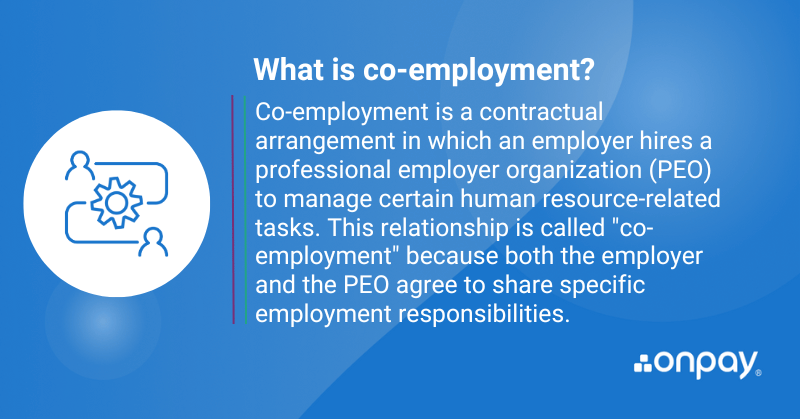Updated: November 9, 2024
Co-employment definition and meaning
Co-employment is a contractual arrangement in which an employer hires a professional employer organization (PEO) to manage certain human resource-related tasks. This relationship is called “co-employment” because both the employer and the PEO agree to share specific employment responsibilities.
More about co-employment and its purpose
Being an employer takes a lot of time and energy. Not only must you strive to hire qualified people, but you must also lead and develop them so that they remain committed to your organization. Along with that, you must properly compensate them through competitive wages and benefits. There’s also the issue of compliance, which includes making sure that employees are familiar with (and follow) company policies and that the business complies with all applicable employment laws.
Failure to properly execute these back office responsibilities can lead to employee turnover, wage-and-hour lawsuits, and even the potential for governmental penalties arising from noncompliance. Employers looking to mitigate such risks may want to consider co-employment.
In a co-employment relationship, the PEO agrees to manage certain HR-related obligations for the client/employer. Importantly, the employer retains control over its business operations and employment decisions, including hiring, firing, and managing employees on a day-to-day basis. The allocation of duties should be outlined in the contract, normally called a “client service agreement,” or CSA.

Advantages of co-employment
In most cases, reputable PEOs leverage industry experts and modern technology to meet the human resources needs of their clients, though it depends on what’s agreed to in each CSA. This enables the client to focus more on strategic endeavors like growing their business and remaining competitive.
In addition, co-employment typically offers the following:
- Full-service payroll administration, which often includes gross-to-net calculations, wage garnishment administration, voluntary benefits deductions, payroll tax withholding, paycheck distribution, W-2 processing, remitting payments to third parties, recordkeeping, and filing payroll taxes under the PEO’s Employer Identification Number.
- Access to competitive benefits. It should be noted that small employers, particularly those with between 10 and 99 employees, account for the largest users of co-employment arrangements. However, small employers often struggle to secure high-quality and affordable benefits like health insurance on their own. In a co-employment relationship, the PEO uses its group-buying power to help clients obtain competitive benefits for their workforce.
- Additional HR support. In a co-employment relationship, the client/employer normally does the hiring (and any firing). That said, the PEO can provide related support, such as onboarding, benefits administration, employee training, and strategic guidance to help boost employee productivity. Moreover, the PEO can provide insights on workplace trends and the regulatory landscape to keep their clients informed on best practices and in compliance with applicable laws.
Potential risks of co-employment
Over-reliance on the PEO
Because PEOs tend to handle much of their client’s HR responsibilities, there’s a chance a company can become overly dependent on the PEO. They may expect the PEO to handle tasks beyond the CSA, merely because they pertain to HR. It’s important for the client to always be aware of their own responsibilities as an employer versus those of the PEO.
For instance, although the PEO administers payroll, the employer should have a system for educating employees on its timekeeping procedures so that they can be paid accurately and on time. The employer should also ensure funding for each payroll cycle. Furthermore, the employer should monitor the PEO’s work to some extent, rather than assuming the PEO is on top of everything.
Problems with the IRS
In general, employers are responsible for withholding taxes from their employees’ wages and reporting those taxes (plus their own share) to the IRS. In a co-employment relationship, however, things can get complicated on the taxation side.
Ultimately, if the PEO fails to make payments, the employer may still be responsible, even if they provided the PEO with the funds for remittance to the IRS. To prevent this, the employer should choose a PEO that is certified with the IRS. In this case, the Certified Professional Employer Organization (CPEO) is solely responsible for remitting payments to the IRS and filing the necessary returns on the client’s behalf.
Co-employment vs. employee leasing
In a co-employment relationship, the PEO becomes the “co-employer” in order to deliver administrative HR and payroll services to the client, not to provide staffing solutions. As a result, the client is responsible for recruiting, interviewing, and selecting new employees, plus the performance management that comes with the territory. Should the relationship with the PEO and the client end, the client retains its employees.
Employee leasing, on the other hand, is when a staffing agency provides workers to a business on a temporary basis. These leased workers are actually employed by the staffing firm, which is responsible for funding their own payroll and making timely wage payments to these workers. Once they complete the temporary assignment, the staffing agency can choose to send them on another job.
A key distinction is that co-employment is typically regarded as a long-term HR management strategy, while employee leasing is thought of as a short-term staffing solution.
Using co-employment in a sentence
“We entered into a co-employment relationship with a PEO so that we could focus more on growing our small business. This decision has saved us a lot of time when it comes to managing our HR and payroll responsibilities.”
Terms related to: Co-employment
Articles and resources related to: Co-employment

